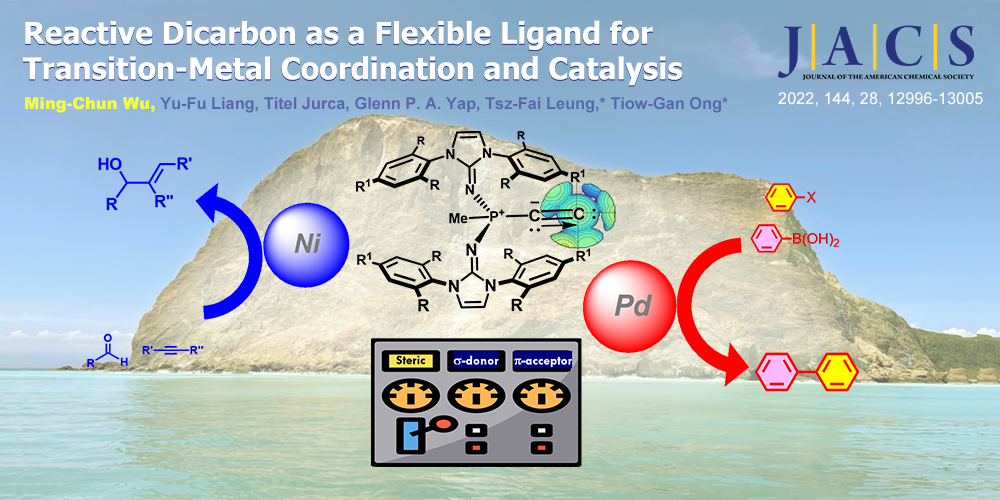高活性雙原子碳分子作為一個廣用的配位基應用於過渡金屬配位以及催化反應當中
Reactive Dicarbon as a Flexible Ligand for Transition-Metal Coordination and CatalysisThe Journal of American Chemical Society 2022, 144, 28, 12996-13005
Ming-Chun Wu, Yu-Fu Liang, Titel Jurca, Glenn P. A. Yap, Tsz-Fai Leung,* Tiow-Gan Ong*

Dicarbon is a reactive carbon allotrope that naturally exists only in the high-temperature medium of stellar space. We report the successful preparation of a series of bottleable phosphine-stabilized dicarbon (PDC) molecules. We explore the use of these molecules as a new complementary class of carbenelike ligands featuring strong σ-donor (>NHCs and CAAcs) but weak π-acceptor properties. Steric map analysis of PDC based on Cavallo’s SambVca program reveals comparable steric volume bulk of 32.5%, similar to the conventional IMes carbene. However, our PDCs exhibit dynamic steric flexibility modulated by the nature of the metal complexes and catalytic reaction environment. We demonstrate the catalytic utility of the PDC framework by its successful implementation for Suzuki−Miyaura cross-coupling and the reductive coupling reaction of an aldehyde and alkyne. Detailed investigations of the reductive coupling reaction reveal an important secondary interaction between PDC and metal complexes, which plays a critical role in the catalytic system.
雙原子碳 (C2) 是一種具有高活性的分子,在自然界中僅存在於外太空或者星際之間。在本論文中,我們選用了具有特定立體障礙的膦化物配位基,成功合成了於常溫下可穩定存在的單配位基雙原子碳分子 (phosphine-stabilized dicarbon, PDC),並且發現 PDC 可作為一種新的類碳烯配位基,其具有很強的σ-予體能力(強於 NHCs 和 CAAcs)與稍弱的π-受體特性。在立體空間分析中,藉由 Cavallo 的 SambVca 軟體計算出 PDC 對於金屬中心的平均遮掩體積與傳統 IMes 碳烯相似,然而 PDCs 會受到金屬錯合物本身的特性或催化反應環境的調節,在立體空間上展現其可變動性。此外,通過 Suzuki-Miyaura 交叉耦合反應與醛基和炔基的還原偶聯實驗,充分證明了 PDC 於催化反應中所具有的效用,其中於還原偶聯反應的細部探討中,我們發現 PDC 與金屬錯合物的二次交互作用對於催化系統至關重要。
